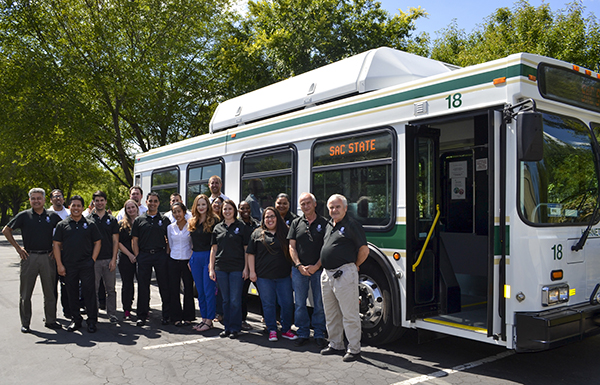 The Hornet Shuttle fleet uses bio-compacted natural gas derived from food waste from the Dining Commons.
The Hornet Shuttle fleet uses bio-compacted natural gas derived from food waste from the Dining Commons.The “green” accolades keep coming in for Sacramento State’s innovative closed-loop program.
The Sac State Sustainability team has picked up its fourth award for the “food to fuel” project, this time from Breathe California of Sacramento-Emigrant Trails, during ceremonies Thursday, May 11, at the Sacramento Railyards. The 2017 Breathe California Clean Air award joins these other prestigious honors:
- The Green California Summit’s waste-management 2017 Leadership Award.
- The Innovative Waste Reduction award from the 2016 California Higher Education Sustainability Conference (CHESC).
- The Best Practice award in 2016 from California State University (CSU) Facilities Management.
Last year, nearly 63 tons of food scraps from the Dining Commons, which serves students living in the residence halls, was converted into bio-compacted natural gas (BioCNG) to run Sac State’s Hornet Shuttle fleet.
“Each academic year, our Hornet Shuttle system provides over 55,000 rides for Sac State students, faculty, and staff, reducing the amount of traffic on roads and emissions in the air – all powered by yesterday’s food waste,” says Tony Lucas, senior director of Sac State’s University Parking and Transportation Services (UTAPS).
And because vehicles run so smoothly on BioCNG, UTAPS opted to buy used rather than new when adding two shuttles to the fleet. There are now eight Hornet Shuttles serving the campus.
Sac State has offset greenhouse gas emission by more than 300 metric tons compared with when gasoline-powered shuttles were in use.
“Not only have we reduced carbon emissions, but we’re not shipping organic waste to landfills, where it would turn into harmful methane gas,” says recycling coordinator Joey Martinez. – Dixie Reid
Return to Made at Sac State Magazine home page
